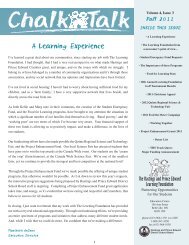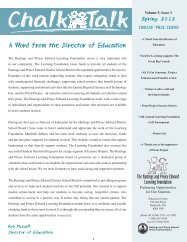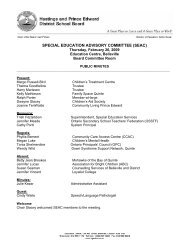Grade 11 Healthy Active Living Education Additional Supports ...
Grade 11 Healthy Active Living Education Additional Supports ...
Grade 11 Healthy Active Living Education Additional Supports ...
You also want an ePaper? Increase the reach of your titles
YUMPU automatically turns print PDFs into web optimized ePapers that Google loves.
Teacher Resource (conÕt)<br />
Mental Health Disorder Research Information Ð Anxiety Disorders<br />
Name of Disorder: Anxiety Disorders<br />
General Description:<br />
Anxiety Disorders are a category of mental disorders characterized by<br />
excessive/inappropriate feelings of anxiousness, combined with physiological symptoms<br />
that interfere with everyday activities. Taken as a group, they are the most common<br />
mental disorders in youth, affecting up to ten percent of children and adolescents.<br />
Phobias, social anxiety disorder, panic attacks, post-traumatic stress disorder and<br />
obsessive compulsive disorder are different forms of anxiety.<br />
Signs/Symptoms:<br />
Physical:<br />
• Easily Fatigued<br />
• Restlessness (inability to relax, feeling<br />
uptight, apprehension)<br />
• Muscle tension<br />
• Disturbed sleep<br />
• Excessive sweating including clammy<br />
hands/feet<br />
• Pounding or racing heartbeat<br />
• Upset stomach (including stomach<br />
pains, diarrhea and nausea)<br />
• Light headedness / dizziness and /or<br />
headaches<br />
• Breathlessness<br />
Emotional:<br />
• Difficulty Concentrating<br />
• Irritability<br />
• Easily distracted<br />
• Fear of losing control<br />
• Prevents someone from doing things<br />
• Disruptive to school and work life<br />
• Disruptive to family and social life<br />
• Extreme need for reassurance<br />
Possible Impact(s) on Life:<br />
• Can be sterotyped as the chronic Òworry wartÓ<br />
• Can lead to the avoidance of many situations (for e.g.,: public speaking, eating or<br />
dressing in public, or school activities such as dances or tests) and social isolation<br />
• Can limit ability to function in daily life:<br />
-self care: bathing, dressing, eating<br />
-family relationships<br />
-social relationships<br />
-going to work or school<br />
-doing household tasks and responsibilities<br />
<strong>Grade</strong> <strong>11</strong> <strong>Healthy</strong> <strong>Active</strong> <strong>Living</strong> <strong>Education</strong> (PPL30), Module #2 Positive Mental Health and Stress<br />
Page 69
















